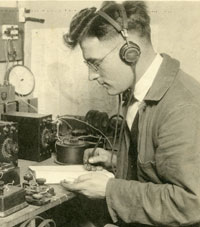
Professor Earle M. Terry can be considered the father of WHA radio. Although he was trained as a theoretical physicist, Terry was highly interested in the practices and applications of physics, and this led him to early radio experimentation. Terry was born in Battle Creek, Michigan on Jan. 16, 1879 and received his Bachelors degree from the University of Michigan in 1902. In 1904 he completed his M.A. at the University of Wisconsin-Madison, and in 1910 finished his Ph.D. with expertise in Ferro-magnetism, electronics, and Piezo-electricity. He was hired as an assistant professor by the university in 1910, was tenured by 1917, and received full professorship by 1928. Sadly, Terry passed in 1929, two years before his innovations led to the fully functioning School of the Air directed by Harold McCarty.
Terry was not the first to experiment with radio frequencies at the University of Wisconsin-Madison. Edward Bennett, a professor in the Physics Department, experimented as early as 1909 (other reports say 1902 or 1906) with sending radio signals across the basement of Sterling Hall, and in 1910 the Physics Department attempted to broadcast a brief concert via radio. However, these tests were conducted more with regard to scientific experimentation than medium exploration. It was Terry who had the foresight to anticipate radio as a broadcast medium that he posited would become as common as ‘bathtubs in every home’ .
But what sparked this interest? Few accounts remain detailing Terry’s primary inspiration to work with radio. Most certainly his collaboration with Edward Bennett was a primary motivating factor. It is also reported that Terry became interested in the applied physics of electric waves when he first strung ‘Lacher wires’ the length of Physics Professor Snow’s lecture room in Science Hall, and experimented with them for several weeks (Miller Letter).
But it was Bennett who obtained a license to experiment with a telegraphic set in 1914 under the call letters 9XM. Randall Davidson, in his history of WHA, points out that ‘9’ represented the north central region of the United States, ‘X’ stood for experimental, and ‘M’ for Madison. In 1915 Terry asked if he could ‘borrow’ the license to experiment with telegraph equipment that he was building, and in June of that year the license was transferred to the University for Terry’s usage. While the physics department was not primarily interested in applied science practices, they tolerated Terry’s interest in radio, though few saw the import of his innovations outside of a core of talented students (including Cyril Jansky and Malcolm Hanson) who would aid Terry with his experimentation in the formative years of 9XM between 1915 and 1920.
The fertile period of 1915 to 1920 saw Terry make important breakthroughs in radio construction and transmission practices. Some of the earliest broadcasting of weather and radiotelegraph, according to Terry’s students, came as early as 1916, when Terry realized that rural phones were too ‘laborious’ and postcards were too slow for getting tornado and storm warnings out ‘in a hurry’. Around this time he gained support from the Agricultural Department and did experimental transmissions with Beloit College, the University of Chicago, and Great Lakes Naval Academy.
The John S. Penn files include correspondence from many of Terry’s former assistants. These letters report on early 9XM experiments as well as some anecdotes about Terry as a professor and person. One letter reports that the early form of the station featured a 4 kilowatt rotary spark-code transmitting apparatus, first put together with a series of Leyden jars to serve as condensers. The jars were mounted on a high rack in the station and because of the high voltages the jars often ‘brushed over’, falling to the floor. To avoid accidents the jars were filled part way with water and floated oil on top as an insulator. Occasionally the voltage would build to the point that the jars would crack, resulting in a deluge of oil and water and a rather complicated mopping job.
Later a huge tank condenser was built and filled with kerosene. A breakdown of the condenser only resulted in an air bubble. But a Terry student later recollected that tank condenser breakdowns still occurred due to the interesting habit of shutting off the rotary spark gap motor before concluding the signing off. Apparently this practice caused a beautiful descending tone to emulate from the transmitter as the last few dots and dashes were sent, but the slowing of the motor obviously built up unreasonably high voltages in the condensers. (Schrage Letter).
Perhaps most famously, when no vacuum tubes were available commercially, Terry mastered the art of glass blowing in order to construct transmission tubes for the station. Jansky and Hanson reportedly aided Terry in this project. Jansky, in a letter to Penn, wrote that although Terry was significantly better at glass blowing than the two, tubes would break so often that he felt it necessary for his students to be able to replace the tubes quickly and efficiently without his oversight. Davidson also reports that one year Terry was too busy with teaching to do any glass blowing until Christmas break. When everyone returned for Spring semester someone noted that he had sealed his tubes with a red color, to which he replied, ‘you see I started making those particular tubes on Christmas day and I used red sealing-in glass by way of celebrating a little’ (Davidson 75). Terry further celebrated Christmas by enjoying a truncated day of work, clocking out at 4pm. Terry was so dedicated to his project that when RCA offered him a yearly salary of $25,000 a year to join the private sector, he declined and stayed in Madison for a salary of only $5,000 a year, stating that ‘a man can live on $5,000’.
Indeed Terry’s studio produced not only innovations in radio technology, but a strong legacy of radio experts. Hanson later accompanied Admiral Byrd as his short wave radio operator in Byrd’s Antarctic expedition, Jansky became an inventor and professor at University of Minnesota, and another of Terry’s students, Paul Heising, was first to perfect a system of modulating continuous radio waves so that the transmission of speech by radio became practical, now known as the Heising system of modulating.
Burton Miller, a former chief engineer of 9XM, credited Terry and William Lighty with implementing the early programming policies of 9XM broadcasts that became station standards as WHA. Terry believed that WHA could and should be the medium for bringing the university into homes of people of Wisconsin. He did not visualize a need for programs paralleling those of commercial stations, and recognized that the university could and should not compete with the commercial outlets. Terry viewed the medium as an instrument capable of bringing knowledge and understanding to all persons and all places (Jansky Letter).
Unfortunately scant documents remain from Terry himself, but the archives do feature a rich backlog of materials from a dissertation written by John S. Penn on 9XM that includes correspondence with former students regarding Terry’s life, programming notes, and some internal documentation from the time.
Digital Documents
Photographs
Photograph of a spark transmitter
Related Links
